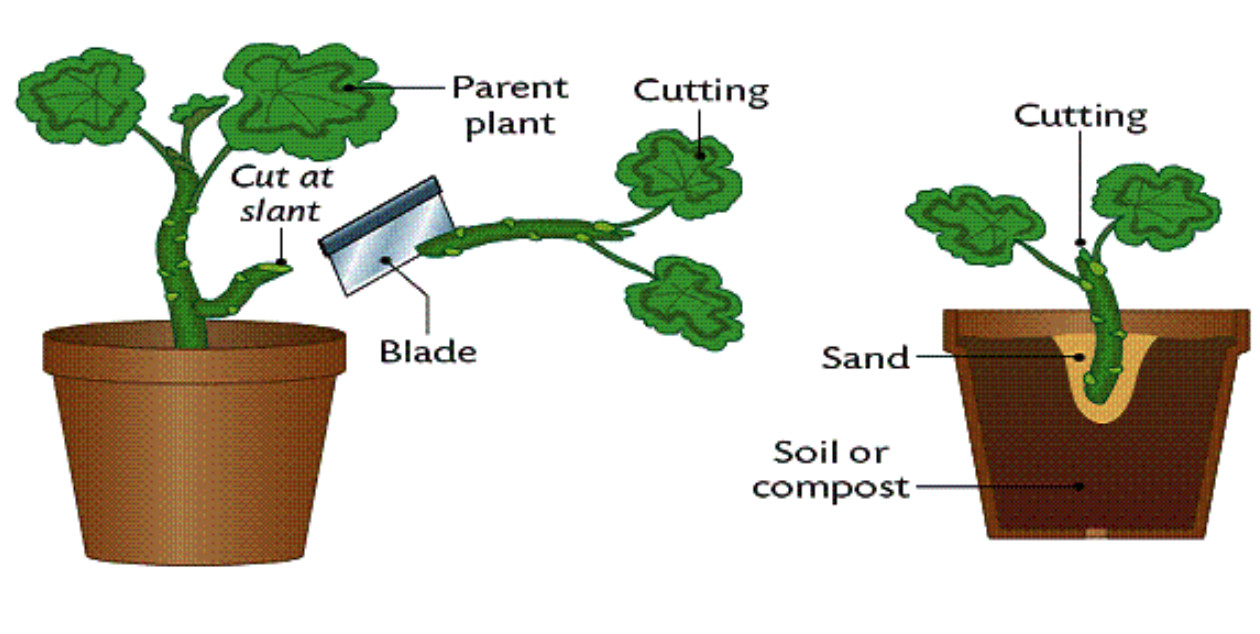These techniques were introduced by the art and science of colonial propagation of plants when the American Society for Horticultural Science (ASHS) was formed in 1903. The cutting types we use today-hardwood, softwood, semi-hardwood, herbaceous, leaf, and root cuttings were used at that time (Bailey, 1891, 1896; Corbett, 1902).
The most common method used by gardeners to propagate their plants is vegetative propagation.
What is vegetative propagation?
Plant propagation can be defined as the multiplication or reproduction of plants in basic terms.
Plant propagation techniques and practices have evolved as a result of the commercialization of crops.
Each technique has its own set of advantages and disadvantages.
Varied propagation methods have different effects on each plant. Various propagation techniques have been devised with the goal of achieving crop uniformity, early bearing, improved production, pest and disease resistance, and the introduction of specific traits into subsequent generations. Plant propagation has become more intriguing and demanding as a result of these goals.
Plant propagation entails the skillful integration of science and art. Through commercial nurseries, basic knowledge and expertise might be a greater source of revenue. It aids in the conservation of plant stocks and the preservation of endangered (extinct) species.
Plants can be propagated in two ways: sexually and asexually. Asexual propagation relies on the use of plant vegetative components to raise new plants, whereas sexual multiplication relies on the use of seeds. Plant reproductive elements such as shoots, leaves, roots, stems, buds, and underground components are employed in a variety of ways to reproduce new plants.
Types of propagation-:
1. Sexual propagation– ‘Sexual propagation’ refers to the process of propagating or multiplying plants through seed. It comprises an ’embryo’ and food material that has been stored, both of which are protected by a ‘ seed coat’.
Successful fertilization and combining of parental gametes result in the formation of seeds. It is an old and simple way for propagating crops such as attractive annuals, vegetables, medicinal herbs, and fruit plants such as papaya.
Merits-:
i)Seed-propagated plants live longer, are more vigorous and are more resistant to biotic (insects, pests, and diseases) and abiotic (environmental) challenges.
ii)It is a simple, easy, and convenient method for the multiplication of plants.
iii)It is only performed to create genetic diversity of plants.
Demerits-:
i)Sexually propagated plants show variations and are not genetically true-to-type to the mother plants.
ii)Crop species, which do not produce seeds like pineapple, banana, strawberry, fig, jasmine, hibiscus, bougainvillea, etc., cannot multiply by this method.
iii)The benefits of rootstocks and scions in asexual propagation cannot be utilized using the sexual technique.


2. Asexual propagation-:It’s also referred to as ‘vegetative propagation.’ Plant vegetative parts such as leaves, stems, and roots, as well as their modified forms, are employed for propagation. The majority of horticultural crops are propagated commercially via vegetative or asexual methods.
Merits-:
i)Old and economically low-productive fruit trees can be transformed into outstanding ones by top-working (by budding and grafting).
ii)Rootstocks and scions can provide a number of benefits exploited in an asexual manner.
iii)Maturity is consistent, and the plant produces high-quality fruit.
iv)Asexually propagated plants have a shorter lifespan than sexually propagated plants because of their small size, chemical spraying and harvesting are simple.
v)This approach facilitates the development of noble plants, such as blossoms of various colors on the same rose plant, and a variety of mangoes on the same mango tree only asexual reproduction is possible.
Demerits-:
i)New varieties cannot be created through vegetative propagation.
ii)Because it necessitates specialized knowledge, it is a costly technique of dissemination.
iii)Asexually propagated plants have a shorter lifespan than sexually propagated plants.
iv)These plants are more vulnerable to biotic and abiotic stressors than other plants.


What are the different ways of propagation?


- Cutting
Cutting is a plant’s detached vegetative part that, when separated and planted, can repair missing parts and develop into a new plant. It is a low-cost and fast method of propagation.
With only a few parent plants, a great number of uniform plants can be created. It does not necessitate the use of specialized expertise. The process is named for the plant part that is cut, such as the stem, root, or leaf.
- Layering
It is a propagation method that is attached. Roots are allowed to develop on the covered area of the stem while still linked to the mother plant in this approach.
Following the emergence and growth of the roots, this piece of the plant is detached from the mother plant and allowed to grow on its own root stem as a new plant. The term ‘layer’ refers to such a root stem.
- Grafting
Grafting is the process of uniting sections of two plants to generate a single unit that functions as a single plant.
- Rootstock
The rootstock is the component of the graft that supplies the grafted plant with a root system. Seeds are usually planted in the seedbed and then transported to the nursery bed for budding and grafting. Rootstocks are grown in pots and polythene bags as well.
- Scion
The graft combination’s upper component was derived from the ‘Scion’ which refers to the desired plant that will be multiplied.
There are several ways to decorate your garden and nowadays, vegetative propagation is the most widely used process to beautify gardens. The fundamental benefit of vegetative propagation methods is that the resultant plants carry only one parent’s genetic material, making them clones of the parent plant. For commercial plant production, this can save a lot of time and money.
Also Read: 6 Amazing Japanese Garden Ideas.







Leave feedback about this